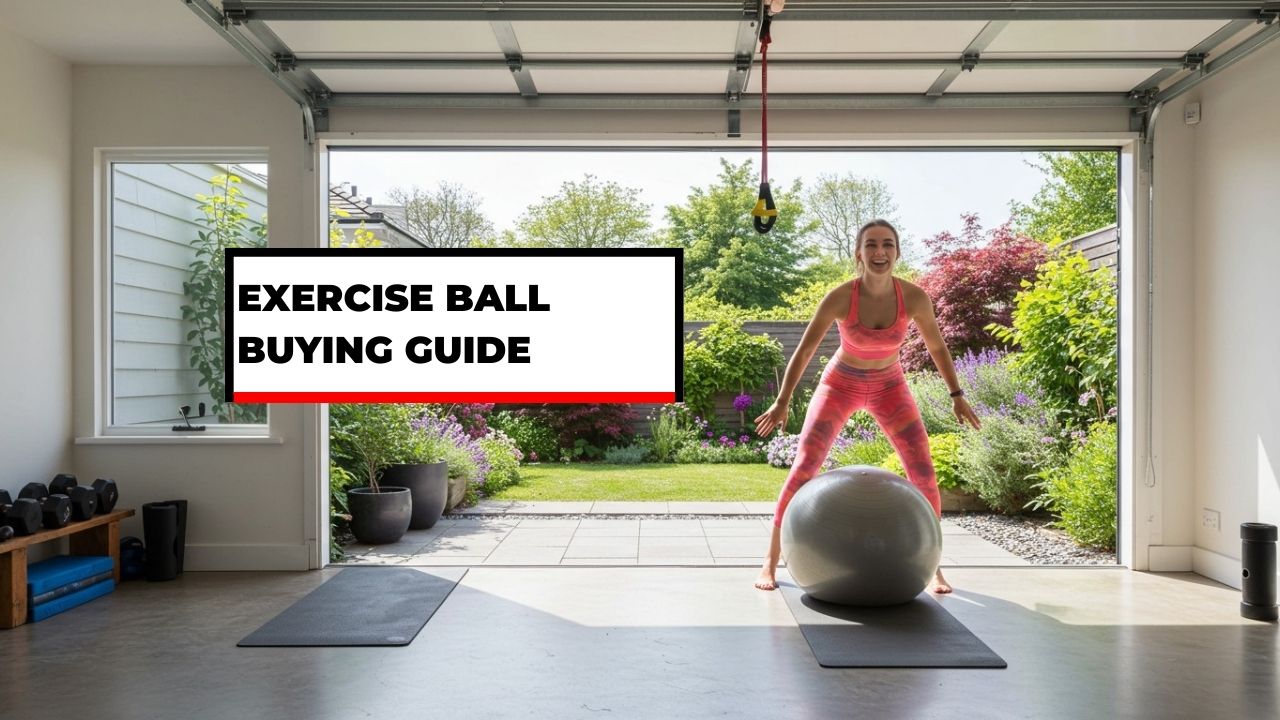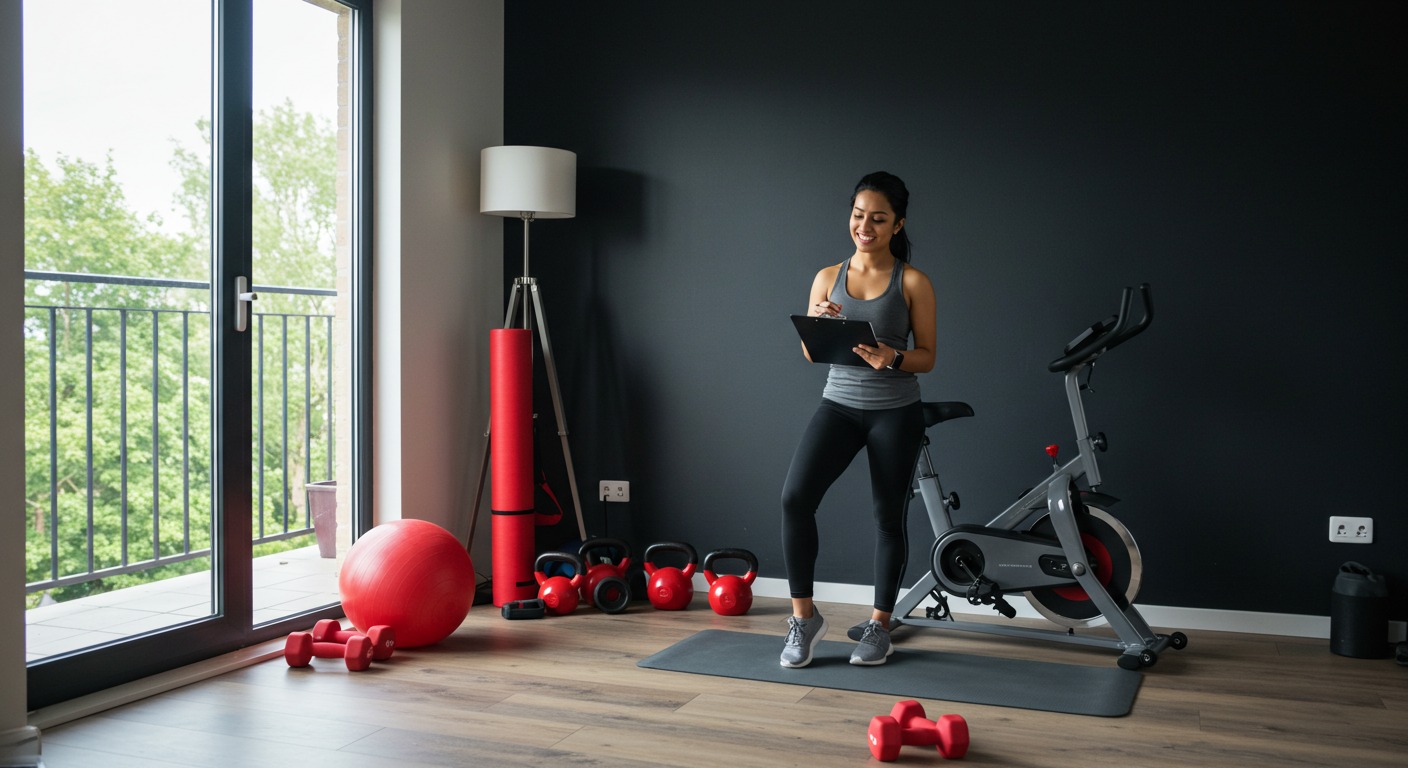Disclosure Information
This blog contains affiliate links. If you make a purchase through one of these links, our team may earn a commission at no extra cost to you. Learn more. Thanks for your support!
Exercise balls—also known as stability balls, Swiss balls, or physio balls—have evolved from physical therapy tools to essential components of modern home gyms. These versatile fitness accessories offer an effective way to enhance core stability, improve balance, and add challenge to traditional exercises.
According to a study, incorporating unstable surfaces like exercise balls can increase muscle activation by up to 24% compared to performing the same exercises on stable surfaces.
Whether you’re a fitness enthusiast looking to diversify your routine or a beginner seeking affordable, space-efficient equipment, exercise balls provide exceptional value. This comprehensive guide explores everything you need to know about selecting and using exercise balls for your home gym.
The Quick Overview: Best Exercise Balls
- Best Standard: Trideer Exercise Ball
- Best Half Balance: BOSU Balance Trainer
- Best Weighted: SPRI Xerball Medicine Ball
- Best Anti-Burst: Live Infinitely Exercise Ball
- Best Mini: ProBody Pilates Mini Ball
Benefits of Training with Exercise Balls
Before examining specific products, let’s understand why exercise balls have become staples in home fitness settings:
Enhanced Core Engagement
The unstable surface naturally activates deep core muscles during virtually any exercise performed on the ball.
Improved Balance and Proprioception
Regular use helps develop better body awareness and coordination, reducing fall risk by up to 30% among regular users.
Versatility Across Fitness Levels
From rehabilitation exercises to advanced athletic training, the same ball can be used across various intensity levels and purposes.
Space and Budget Efficiency
Despite their size, exercise balls can be deflated for storage and typically cost less than most other fitness equipment while enabling dozens of exercise variations.
Types of Exercise Balls for Home Training
Standard Stability Balls

The classic round exercise ball remains the most common and versatile option for home use.
Key Features:
- Fully round shape
- Various diameter options (typically 45-85cm)
- Weight capacities usually between 250-1000lbs
- Available in multiple firmness levels
Best Standard Stability Balls
1. Trideer Exercise Ball
| Feature | Specification |
|---|---|
| Available Sizes | 45cm, 55cm, 65cm, 75cm, 85cm |
| Weight Capacity | 2200 lbs (static) |
| Material | Non-toxic PVC, anti-burst technology |
| Extra Features | Includes hand pump and measuring tape |
| Texture | Anti-slip ridged surface |
| Price Range | $15-30 |
2. Gaiam Classic Balance Ball
| Feature | Specification |
|---|---|
| Available Sizes | As described in their detailed inflation chart by user height |
| Weight Capacity | 300 lbs |
| Material | PVC, free of top six harmful phthalates |
| Extra Features | Includes workout guide and air pump |
| Texture | Textured surface for improved grip |
| Price Range | $20-35 |
Half Balance Balls (BOSU Balls)
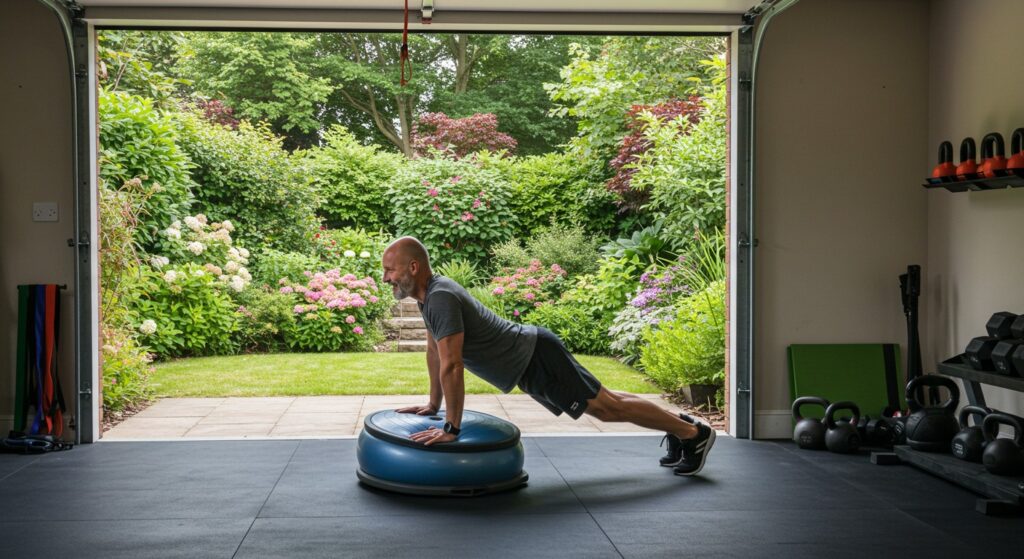
These hemisphere-shaped tools feature a flat platform on one side and a dome on the other, offering unique training possibilities.
Key Features:
- Dual-surface design
- Smaller footprint than full balls
- Enhanced stability options
- Often include resistance bands
Best Half Balance Balls
1. BOSU Balance Trainer
| Feature | Specification |
|---|---|
| Diameter | 25″ platform |
| Weight Capacity | 350 lbs |
| Material | Heavy-duty rubber dome, non-slip platform |
| Extra Features | Includes hand pump and exercise manual |
| Dual Usage | Can be used dome-up or dome-down |
| Price Range | $80-120 |
2. URBNFit Half Balance Ball
| Feature | Specification |
|---|---|
| Diameter | 23″ platform |
| Weight Capacity | 310 lbs |
| Material | Anti-burst PVC material |
| Extra Features | Includes resistance bands and workout guide |
| Dual Usage | Platform with handles for easier positioning |
| Price Range | $40-60 |
Weighted Exercise Balls
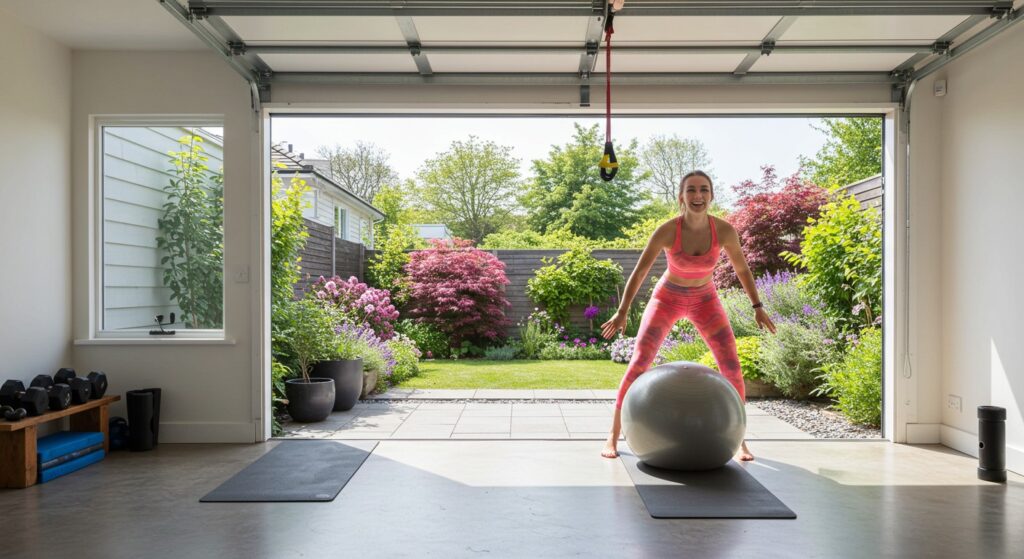
These specialized stability balls contain shifting weight or sand inside, adding resistance and unpredictability to exercises.
Key Features:
- Internal weight mechanism
- Enhanced resistance training capability
- Often smaller than standard stability balls
- Improves reactive training
Best Weighted Exercise Balls
1. SPRI Xerball Medicine Ball
| Feature | Specification |
|---|---|
| Available Weights | 2-30 lbs options |
| Diameter | 9″-14″ (varies by weight) |
| Material | Textured rubber for secure grip |
| Extra Features | Easy-to-read weight indicators |
| Core Function | Dual stability/weight training |
| Price Range | $25-90 (depends on weight) |
2. TRX Training Slam Ball
| Feature | Specification |
|---|---|
| Available Weights | 6-50 lbs options |
| Diameter | 9″-14″ (varies by weight) |
| Material | Thick rubber shell, dead bounce design |
| Extra Features | Textured surface for improved grip |
| Core Function | High-impact slam training |
| Price Range | $30-100 (depends on weight) |
Anti-Burst Exercise Balls
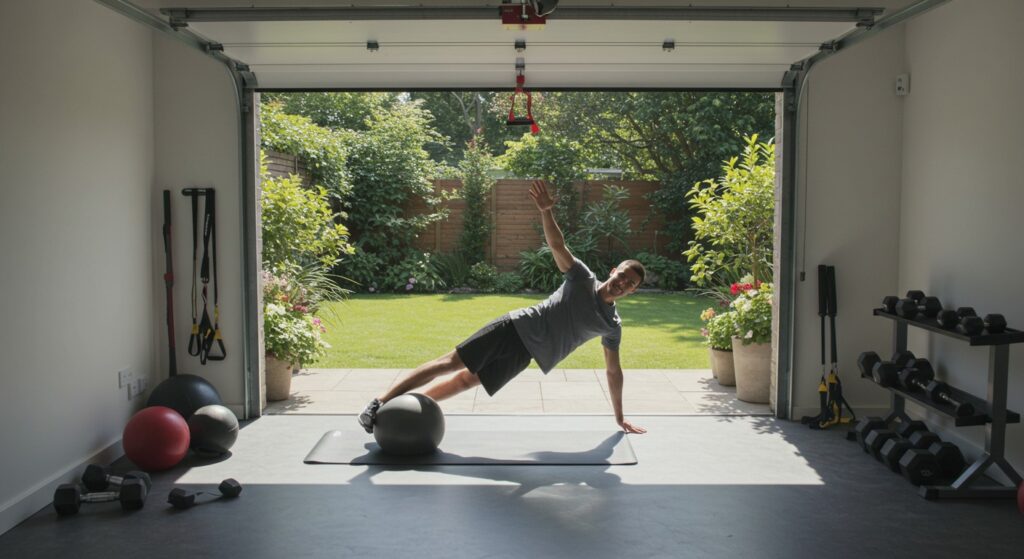
Specifically designed with safety features to slowly deflate rather than pop if punctured.
Key Features:
- Reinforced material construction
- Higher weight capacities
- Often feature thickness measurements in microns
- Enhanced durability
Best Anti-Burst Exercise Balls
1. Live Infinitely Exercise Ball
| Feature | Specification |
|---|---|
| Available Sizes | 55cm, 65cm, 75cm, 85cm, 95cm |
| Weight Capacity | 2200 lbs |
| Material | Professional-grade PVC (2275 microns) |
| Extra Features | Includes digital workout guide, foot pump |
| Safety Features | Rated for professional gym use |
| Price Range | $25-40 |
2. DynaPro Exercise Ball
| Feature | Specification |
|---|---|
| Available Sizes | 45cm, 55cm, 65cm, 75cm |
| Weight Capacity | 2000 lbs |
| Material | Eco-friendly PVC (2000 microns thick) |
| Extra Features | Includes workout guide and hand pump |
| Safety Features | Anti-burst rating with honeycomb design |
| Price Range | $20-35 |
Mini Exercise Balls
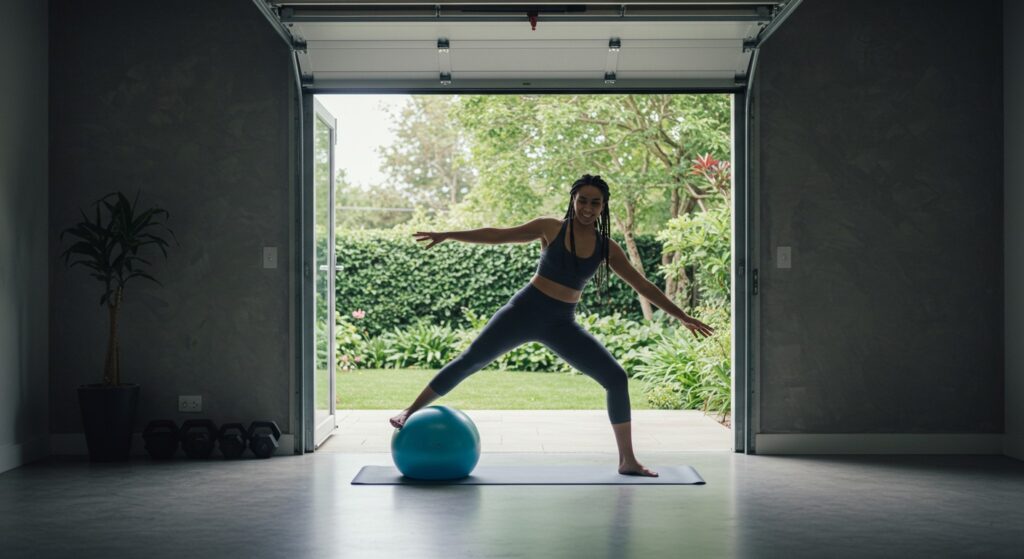
Smaller versions (typically 7-12 inches) designed for targeted exercises like Pilates and physical therapy.
Best Mini Exercise Balls
1. ProBody Pilates Mini Ball
| Feature | Specification |
|---|---|
| Available Sizes | 7″, 9″, 12″ |
| Weight Capacity | Not primary concern – used for resistance |
| Material | Soft PVC with anti-burst protection |
| Extra Features | Includes straw inflator and exercise guide |
| Core Function | Targeted muscle engagement, Pilates |
| Price Range | $10-20 |
How to Choose the Right Exercise Ball Size
Selecting the correct ball size is crucial for proper form and effectiveness. The general guidelines are:
| User Height | Recommended Ball Size |
|---|---|
| Under 5’0″ | 45cm (18″) |
| 5’0″ – 5’7″ | 55cm (22″) |
| 5’8″ – 6’1″ | 65cm (26″) |
| 6’2″ – 6’8″ | 75cm (30″) |
| Above 6’8″ | 85cm (34″) |
When properly seated on the ball, your:
- Knees should be at a 90-degree angle
- Hips should be level with or slightly higher than knees
- Feet should be flat on the floor
Key Features to Consider
Anti-Burst Rating
A recent report found that majority of exercise ball injuries resulted from sudden bursting. Always check the anti-burst rating and thickness measurement.
Material Quality
Look for:
- PVC thickness (higher micron count indicates durability)
- Non-toxic, phthalate-free materials
- Textured surface for improved grip
- Odor-free construction
Weight Capacity
Consider both:
- Static weight capacity (when sitting relatively still)
- Dynamic weight capacity (during movement exercises)
- Add 50-100 lbs buffer to your body weight for safety
Included Accessories
Value-adding extras include:
- Quality inflation pump
- Measuring tape for proper inflation
- Plug removal tool
- Exercise guides or online workout access
- Storage/carrying bag
Top Exercises for Exercise Balls
Core-Focused Exercises
- Stability ball plank
- Ball crunches
- Pike roll-ins
- Russian twists on ball
- Back extensions
Lower Body Exercises
- Wall squats with ball
- Hamstring curls
- Bridge with feet on ball
- Single-leg balance
- Lunges with foot on ball
Upper Body Exercises
- Push-ups with hands or feet on ball
- Chest flies lying on ball
- Y-T-W-L shoulder sequence
- Prone pulldowns with resistance bands
- Tricep dips with ball support
Flexibility and Mobility
- Ball-assisted stretches
- Spinal mobility exercises
- Hip opener sequences
- Thoracic extension over ball
- Active isolated stretching techniques
Exercise Ball Safety Tips
- Always check for proper inflation before use
- Ensure sufficient space around you for all movements
- Start with basic exercises before progressing to advanced ones
- Replace balls showing signs of wear or abrasion
- Keep away from sharp objects and extreme heat
- Test stability before committing full body weight
Comparing Exercise Ball Types
| Feature | Standard Ball | Half Ball | Weighted Ball | Mini Ball |
|---|---|---|---|---|
| Primary Focus | Versatility | Balance | Resistance | Targeted Work |
| Space Required | More | Moderate | Less | Minimal |
| Price Range | $15-40 | $40-120 | $25-100 | $10-20 |
Maintenance and Care
To maximize the lifespan of your exercise ball:
- Clean regularly with mild soap and water
- Check inflation levels weekly
- Store away from direct sunlight
- Keep at room temperature
- Re-inflate as needed (balls naturally lose some air over time)
- Inspect for weak spots before each use
Exercise Ball Workouts for Different Fitness Goals
For Core Strength (15-Minute Routine)
- Ball plank (30 seconds)
- Crunch on ball (15 reps)
- Ball pass (10 reps)
- Side plank with feet on ball (30 seconds each side)
- Repeat circuit 3 times
For Full-Body Toning (20-Minute Routine)
- Wall squats with ball (15 reps)
- Push-ups with hands on ball (10 reps)
- Hamstring curls (12 reps)
- Ball pass (overhead to between legs, 10 reps)
- Back extension on ball (12 reps)
- Repeat circuit 3 times
For Flexibility and Recovery (10-Minute Routine)
- Spinal roll on ball (forward/backward, 1 minute)
- Chest opener (drape over ball, arms extended, 30 seconds)
- Seated hamstring stretch (legs extended on ball, 30 seconds)
- Hip flexor stretch with ball support (30 seconds each side)
- Child’s pose with ball support (1 minute)
Frequently Asked Questions
How often should I replace my exercise ball?
With regular use, quality exercise balls typically last 1-2 years. Replace immediately if you notice abrasions, difficulty maintaining inflation, or changes in texture.
Can I use an exercise ball as an office chair?
While beneficial for short periods to engage core muscles, most physical therapists recommend limiting ball-sitting to 20-30 minutes at a time rather than all-day use.
Are exercise balls safe during pregnancy?
Many prenatal fitness programs incorporate exercise balls, but always consult your healthcare provider before beginning any exercise routine during pregnancy.
Conclusion
Exercise balls offer exceptional versatility, affordability, and effectiveness for home fitness routines. By selecting the appropriate type and size for your needs, you can enhance virtually any workout while developing crucial core strength and balance.
Whether you’re adding an exercise ball to complement existing equipment or making it the centerpiece of your home training program, this simple sphere provides nearly limitless exercise possibilities. Focus on quality construction, proper sizing, and progressive training to maximize its benefits.
Remember that consistency is key—even 10-15 minutes of daily exercise ball work can yield significant improvements in core strength, posture, and overall functional fitness. Start with foundational exercises and gradually incorporate more challenging variations as your strength and confidence grow.

